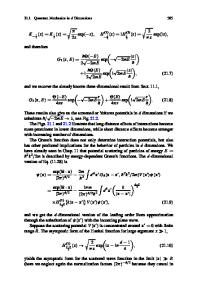The Physics of Low Dimensional Materials
- PDF / 268,539 Bytes
- 1 Pages / 585 x 783 pts Page_size
- 12 Downloads / 291 Views
The Physics of Low Dimensional Materials Frank J. Owens World Scientific, 2017 172 pages, $88.00 (e-book $70.00) ISBN 978-981-3225-85-5
T
his is an excellent book on the physical properties of low-dimensional carbon and newer noncarbon materials. There are nine chapters covering the physical properties of low-dimensional materials employing elementary theories of solids. This book will be useful for researchers working on low-dimensional materials. Chapter 1 provides an overview of theoretical approaches used to predict the properties of low-dimensional materials with example calculations. Brief overviews of molecular orbital theory and density functional theory are discussed with appropriate diagrams. Chapter 2 presents the electronic properties of low-dimensional solids. Free-electron theory and the tight-binding model are employed in discussing the band and electronic structure of solids. Chapter 3 deals with vibrational properties of low-dimensional materials. The
basics of Raman spectroscopy and surface-enhanced Raman spectroscopy are discussed with illustrations and experimental data for graphite. Chapter 4 discusses fabrication and characterization of single-walled and multiwalled carbon nanotubes. How the energy bandgap changes with size and how the frequencies of radial breathing modes changes with the nanotube diameter are well discussed. Chapter 5 gives an overview of the physical properties of boron nitride nanotubes, boron, and silicon nanotubes. Raman spectra, infrared spectra, and high-resolution transmission electron microscopy images included are useful. Graphene structures and their physical properties are presented in chapter 6. The anomalous quantum Hall effect in graphene structures is briefly discussed with the help of energy state diagrams. Identifying the number of layers using Raman spectra is discussed beautifully.
Materials for the 21st Century David Segal Oxford University Press, 2017 336 pages, $75.00 (paperback $32.95, e-book $25.99) ISBN 978019880406
T
his reference book is aimed at highschool students and the general public. It is written from the perspective that materials hold the key to solving 21st century problems, especially in the areas of energy, communications, and human health. The book has 13 short chapters followed by a descriptive glossary that
892
lists 500 materials. The appendices that follow direct the reader to a comprehensive list of books on materials science topics and selected patent documents. Chapter 1 discusses the important role of materials in the 21st century economy. Chapter 2 focuses on carbohydrates, processing of sugars by the human body, and
Chapter 7 presents an overview of other low-dimensional materials, such as boron nitride, MoS2, NbSe2, and selenium. The highest occupied molecular orbital and lowest occupied molecular orbital energylevel dependency on the wave vector in all of these structures are depicted well. Chapter 8 discusses magnetism in low-dimensional materials. The basics of magnetism and experimental techniques to probe the ma
Data Loading...









